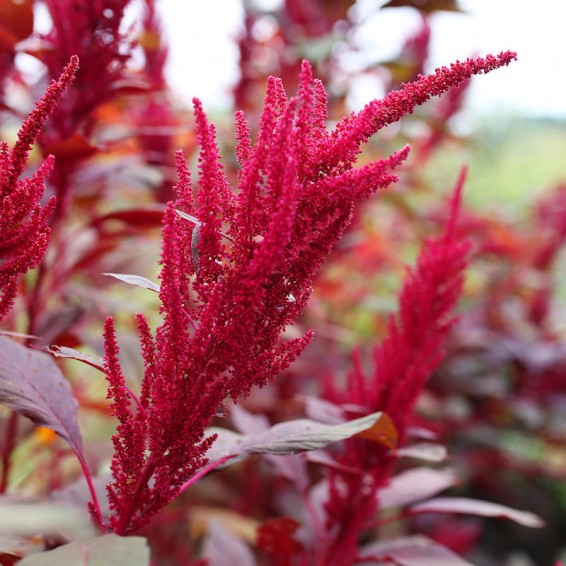Organic Red Garnet Amaranth Seeds
Amaranthus tricolor
- HOW TO GROW
- FAST FACTS
HOW TO GROW
Sowing: Amaranth germinates when the soil temperature reaches at least 70 degrees F, so gardeners in cool climates may want to start their seed indoors 4-6 weeks before transplanting. Direct sow the seed several weeks after the last spring frost; sow thinly 1/4" deep in rows 16-18" apart, thinning the seedlings to 10-12" apart as soon as they appear. Some gardeners prefer closer spacing such as 2-3" if harvesting the greens only. Amaranth prefers full sun and well drained soil. Germination should occur within 8-10 days.
Growing: Amaranth tolerates drought very well once established, but the the greens will be more tender if the soil is kept moist.
Harvesting: Amaranth greens can be harvested as soon as they grow big enough for eating, and continue producing well into late summer. For the best flavor, harvest the leaves before the plant flowers; the leaves will begin to mature in about 40 days after planting. Individual leaves can be lightly harvested from each plant even if the goal is to harvest the grain, which will mature about 120 days after planting. To harvest the grain, remove the seed heads individually as they ripen or cut the whole plant and hang it to dry when most of the heads have ripened. Spread out the heads to dry on a surface out of direct sunlight. When they have dried completely, rub or shake them to remove the grain; winnowing or screening may be necessary to remove debris. Another method of harvesting is to shake the seed heads into a container every day when they begin to ripen. If the plant is left to mature and drop its seed, it will attract many birds.
Seed Saving: To harvest the seed, remove the seed heads individually as they ripen or cut the whole plant and hang it to dry when most of the heads have ripened. Spread out the heads to dry on a surface out of direct sunlight. When they have dried completely, rub or shake them to remove the seeds; winnowing or screening may be necessary to remove debris. Another method of harvesting is to shake the seed heads into a container every day when they begin to ripen. Store the seed in a cool, dry place for up to five years.
FAST FACTS
Common Names: Joseph's Coat, Tampala, Summer Poinsettia, Chinese Spinach, Vegetable Amaranth, Een Choy
Latin Name: Amaranthus tricolor
Species Origin: South America, Africa, Indochina
Type: Open Pollinated, Heirloom, Warm Season
Life Cycle: Annual
USDA Zones: 3, 4, 5, 6, 7, 8, 9, 10, 11, 12
Seeds per Ounce: 21,000
Planting Method: From Transplant
Germination Days: 5-20
Planting Depth: 0.2
Planting Spacing: 18
Row Spacing: 16
Days to Maturity: 50
Sunlight: Full Sun, Part Sun
Height: 36 Inches
Color: Red, Green
Bloom Season: Blooms Late Summer, Blooms Early Fall
Pests: Aphids
Diseases: Aster Yellows, Fungal Leaf Spot, Root Rot
DESCRIPTION
HOW TO GROW
Sowing: Amaranth germinates when the soil temperature reaches at least 70 degrees F, so gardeners in cool climates may want to start their seed indoors 4-6 weeks before transplanting. Direct sow the seed several weeks after the last spring frost; sow thinly 1/4" deep in rows 16-18" apart, thinning the seedlings to 10-12" apart as soon as they appear. Some gardeners prefer closer spacing such as 2-3" if harvesting the greens only. Amaranth prefers full sun and well drained soil. Germination should occur within 8-10 days.
Growing: Amaranth tolerates drought very well once established, but the the greens will be more tender if the soil is kept moist.
Harvesting: Amaranth greens can be harvested as soon as they grow big enough for eating, and continue producing well into late summer. For the best flavor, harvest the leaves before the plant flowers; the leaves will begin to mature in about 40 days after planting. Individual leaves can be lightly harvested from each plant even if the goal is to harvest the grain, which will mature about 120 days after planting. To harvest the grain, remove the seed heads individually as they ripen or cut the whole plant and hang it to dry when most of the heads have ripened. Spread out the heads to dry on a surface out of direct sunlight. When they have dried completely, rub or shake them to remove the grain; winnowing or screening may be necessary to remove debris. Another method of harvesting is to shake the seed heads into a container every day when they begin to ripen. If the plant is left to mature and drop its seed, it will attract many birds.
Seed Saving: To harvest the seed, remove the seed heads individually as they ripen or cut the whole plant and hang it to dry when most of the heads have ripened. Spread out the heads to dry on a surface out of direct sunlight. When they have dried completely, rub or shake them to remove the seeds; winnowing or screening may be necessary to remove debris. Another method of harvesting is to shake the seed heads into a container every day when they begin to ripen. Store the seed in a cool, dry place for up to five years.
FAST FACTS
Common Names: Joseph's Coat, Tampala, Summer Poinsettia, Chinese Spinach, Vegetable Amaranth, Een Choy
Latin Name: Amaranthus tricolor
Species Origin: South America, Africa, Indochina
Type: Open Pollinated, Heirloom, Warm Season
Life Cycle: Annual
USDA Zones: 3, 4, 5, 6, 7, 8, 9, 10, 11, 12
Seeds per Ounce: 21,000
Planting Method: From Transplant
Germination Days: 5-20
Planting Depth: 0.2
Planting Spacing: 18
Row Spacing: 16
Days to Maturity: 50
Sunlight: Full Sun, Part Sun
Height: 36 Inches
Color: Red, Green
Bloom Season: Blooms Late Summer, Blooms Early Fall
Pests: Aphids
Diseases: Aster Yellows, Fungal Leaf Spot, Root Rot







